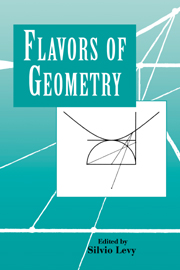An Elementary Introduction to Modern Convex Geometry
Published online by Cambridge University Press: 27 June 2025
Summary
Preface
These notes are based, somewhat loosely, on three series of lectures given by myself, J. Lindenstrauss and G. Schechtman, during the Introductory Workshop in Convex Geometry held at the Mathematical Sciences Research Institute in Berkeley, early in 1996. A fourth series was given by B. Bollobäs, on rapid mixing and random volume algorithms; they are found elsewhere in this book.
The material discussed in these notes is not, for the most part, very new, but the presentation has been strongly influenced by recent developments: among other things, it has been possible to simplify many of the arguments in the light of later discoveries. Instead of giving a comprehensive description of the state of the art, I have tried to describe two or three of the more important ideas that have shaped the modern view of convex geometry, and to make them as accessible as possible to a broad audience. In most places, I have adopted an informal style that I hope retains some of the spontaneity of the original lectures. Needless to say, my fellow lecturers cannot be held responsible for any shortcomings of this presentation.
I should mention that there are large areas of research that fall under the very general name of convex geometry, but that will barely be touched upon in these notes. The most obvious such area is the classical or “Brunn-Minkowski” theory, which is well covered in [Schneider 1993]. Another noticeable omission is the combinatorial theory of polytopes: a standard reference here is [Br ϕndsted 1983].
Information
- Type
- Chapter
- Information
- Flavors of Geometry , pp. 1 - 58Publisher: Cambridge University PressPrint publication year: 1997
Accessibility standard: Unknown
- 10
- Cited by
